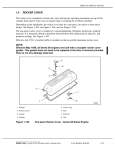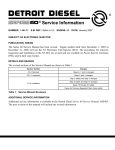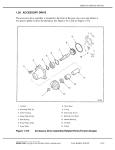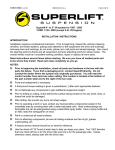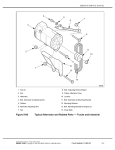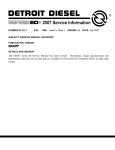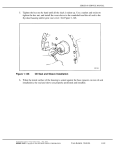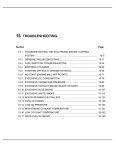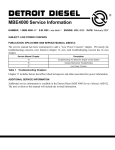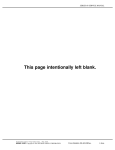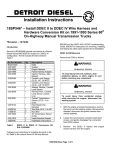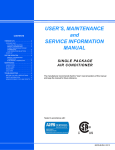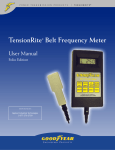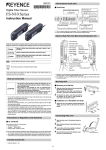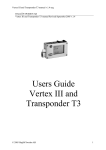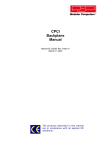Download A1 - DDCSN
Transcript
SERIES 60 SERVICE MANUAL 13.14A DETECTING INTERNAL FUEL LEAKS Used lube oil analysis can identify a potential source of engine trouble before it occurs. A program such as the Detroit Diesel Oil Analysis Program is recommended for monitoring crankcase oil in all engines. One of the most serious conditions used oil analysis can uncover is the presence of excessive fuel in the lube oil which should not exceed 2.5% maximum of oil volume, reference Detroit Diesel’s Publication 7SE270 “Engine Requirements for Lubricating Oil, Fuel and Filters.” While used oil analysis can uncover the presence of excessive fuel in the lube oil, other methods must be used to determine its source. Three particularly effective tests involve the use of special test fuel containing dye additives , the J 37050-A, (on engine) Injector Pop tester, and the J 34760-A Injector Pop-N-Fixture with the J 34760-147A adaptor. 13.14a.1 Prepare Test Fuel The use of J 28431-B Fluorescent dye is effective in fuel leak detection and should be the technician's choice in preparing a test fuel mixture. However, if a “Black light“ or fluorescent dye are not available, red LTO 1140 may be substituted. Prepare Fluorescent Dye J 28431-B as follows: Mix 118 ml (four ounces) of fluorescent dye additive with 15.1 liters (four gallons) of diesel fuel in a clean container marked with the words “Test Fuel”. Prepare Red LTO 1140 as follows: Mix 59 ml (two ounces) of Red LTO 1140 dye additive with 18.9 liters (five gallons) of diesel fuel in a clean container marked with the words “Test Fuel”. 13.14a.2 Fuel Leak Tests (Injectors Installed/Engine Off) To locate a leaking injector the tests below should be completed in the sequence indicated and stopped at a point when the leaking injector is diagnosed. If a leaking injector is found, do not arbitrarily replace more than that injector, as multiple injector malfunctions are rare on the same engine. Multiple injector returns under WARRANTY will require verification by the servicing outlet using the J 34760-A Pop-N-Fixture. All information subject to change without notice. 6SE483 0303 Copyright © 2003 DETROIT DIESEL CORPORATION From Bulletin 6-60-03 13-78a 13.14A DETECTING INTERNAL FUEL LEAKS NOTICE: During fuel pressure testing (engine off, 5 minutes at 50 psi) fuel leakage will be evident at the injector body/plunger spring seat area see Figure 13-22a. Factory tests have shown that accumulation of fuel at each injector, approximately a tablespoon may be evident during these tests. Evidence of fuel in this area is expected, as there is no other place for it to go when the injector cavities are pressurized, forcing fuel between the injector body and plunger. 1. Acceptable Fuel Leakage Figure 13-22a 13.14a.3 Acceptable-Fuel Leakage Between injector Plunger and Body Fuel Pressure Test Since there is no known fuel leak tester available in the commercial market today, one must be fabricated. Use the following guidelines to help in fabricating: Although test fuel can be pressurized by variety of methods, Detroit Diesel recommends an air/fuel accumulator design capable of safely withstanding a minimum pressure of 345 kPA (50 psi). The tester should have a capacity of 9.5 liters (2.5 gallons) of test fuel and provide for contamination free storage of the test fuel when not in use. Regulated shop air may be used to charge the accumulator tank and maintain a constant test fuel pressure. A shut-off valve should be installed at the accumulator outlet to start and stop pressurization during the test sequence. All information subject to change without notice. 13-78b From Bulletin 6-60-03 6SE483 0303 Copyright © 2003 DETROIT DIESEL CORPORATION SERIES 60 SERVICE MANUAL To avoid injury from the sudden release of a high-pressure hose connection, wear a face shield or goggles. To avoid injury from tank rupture or a sudden air hose failure, do not use unregulated air pressure or an accumulator tank with an inadequate pressure rating. Fuel Leak Tester 1. Fill fuel system tester with the fluorescent or red dye fuel mixture approximately 9.5 liters (2.5 gallons). 2. Charge tester (outlet valve closed) with shop air regulated at 345 kPA (50 psi) . Tester hook-up to engine fuel system. There are two options for fuel tester to engine hook-up as determined by the ease of access. Option 1–Remove the fuel line from the outlet side of the fuel pump and connect the fuel system testers line in this fuel hose fitting. This hook-up location will require the fuel system shut-off valve to remain in the open position during testing. About 3.8 liters (1 gallon) of test fuel will be necessary to charge the engine's fuel system from this hook-up location. Test fuel will not harm the engine's fuel filters and may remain in the fuel system at the conclusion of testing. Option 2–Remove the fuel line from the outlet side of the fuel by-pass filter adapter and connect the fuel testers line in this fuel hose fitting. It is recommended that the fuel system shut-off valve be placed in the closed position before removing the engine fuel line and remain closed until reinstalled. About 1.9 liter (0.5 gallon) of test fuel will be necessary to charge the engine's fuel system from this hook-up location. 3. Remove rocker cover and disconnect the fuel outlet line at a convenient location between the cylinder head and the fuel tank. Install an appropriate size pipe plug (loose) in the fuel outlet line end and place it in a container to catch the fuel while priming the cylinder head. If equipped, Jake Brakes® should be removed to allow for the visual examination of the injectors during fuel leak testing and if necessary on-engine injector ’Pop’ test. 4. Slowly open the fuel tester’s shut-off valve and charge the cylinder head fuel galley. When test fuel is flowing from the fuel return line and air has been purged from the system, tighten the pipe plug at the engine fuel outlet line fitting. 5. With the fuel tester shut-off valve completely open and the cylinder head galley pressurized to 345 kPa (50 psi), visually monitor the overhead using a black light for five minutes if the test time goes beyond five minutes it will become more difficult to determine the faulty injector due to expected leakage at the injector plunger/body. Pay special attention to any leaks at the injector body, high and low pressure body plugs, All information subject to change without notice. 6SE483 0303 Copyright © 2003 DETROIT DIESEL CORPORATION From Bulletin 6-60-03 13-78c 13.14A DETECTING INTERNAL FUEL LEAKS see Figure 13-22b and see Figure 13-22d, injector nut to body and nut to tube seals see Figure 13-22c, and stop valve cover see Figure 13-22e. NOTICE: Injector plunger/body leakage at the follower spring area is normal and expected during this test. NOTICE: The figures that follow do not illustrate amount of fuel leakage but rather its origin or location. If injector(s) are removed and reinstalled in the head, the injector nut ’O’ ring seals should be replaced with new parts. NOTICE: If pressurization testing does not reveal the leaking injector, proceed to section Injector ’Pop’ test (On Engine) with J 37050-A. 1. Fuel Leakage at Low Pressure Body Plug Figure 13-22b Unacceptable-Fuel Leakage at Low Pressure Body Plug All information subject to change without notice. 13-78d From Bulletin 6-60-03 6SE483 0303 Copyright © 2003 DETROIT DIESEL CORPORATION SERIES 60 SERVICE MANUAL 1. Fuel Leakage at Injector Nut-to-Tube ’O’ Ring Seal Figure 13-22c Unacceptable-Fuel Leakage at Injector Nut-toTube ’O’ Ring Seal 1. Fuel Leakage at High Pressure Body Plug and or Body Crack Figure 13-22d Unacceptable-Fuel Leakage at High Pressure Body Plug and or Body Crack All information subject to change without notice. 6SE483 0303 Copyright © 2003 DETROIT DIESEL CORPORATION From Bulletin 6-60-03 13-78e 13.14A DETECTING INTERNAL FUEL LEAKS 1. Fuel Leakage at Injector Stop Valve Cover Figure 13-22e Unacceptable-Fuel Leakage at Injector Stop Valve Cover 6. Correct the cause of any abnormal fuel leaks. 7. Bleed the pressure from the accumulator tank and remove the pipe plug from the fuel outlet line. Reinstall the fuel outlet line in the engine’s fuel system. Disconnect the fuel tester and reinstall the fuel inlet line in the engine’s fuel system. 8. Completely open the engine’s fuel shut-off valve and assure that all fuel connections are tight. Reinstall the rocker cover and start engine to purge the air from the fuel system. If the engine fails to start, it may be necessary to prime the fuel system. 13.14a.4 Injector ’Pop Test (On Engine) With J 37050-A Perform this test if injector leakage cannot be identified after pressure testing the cylinder head. Energizing and stoking the suspect injector(s) will produce the internal fuel pressures created during engine operation, thus increasing any abnormal fuel leakage. Refer to manufacture’s instructions supplied with the J 37050-A tester for set-up procedure. Perform the following steps for the Injector Pop Test. 1. Wipe down the overhead to remove any test fuel generated from previous testing. 2. Disconnect both 5-way injector harness connectors at the ECM. 3. Connect alligator clips from the tester cable to the EUI. It is not necessary to disconnect the solenoid terminal leads from the EUI engine wiring harness if the 5-way injector harness connectors have been removed from the ECM. All information subject to change without notice. 13-78f From Bulletin 6-60-03 6SE483 0303 Copyright © 2003 DETROIT DIESEL CORPORATION SERIES 60 SERVICE MANUAL 4. Connect power supply clips to the vehicles 12 volt battery. Red to Positive(+) and Black to Negative(-). 5. Option 1–Connect remote starter cable to the vehicle starter motor. 6. Option 2–Operate vehicle starter switch from drivers seat in the cab. 7. Depress and hold trigger on tester's pistol grip start button while rotating 'current' control knob clockwise to increase current to the injector solenoid. NOTICE: The Letter ’O’ at the left side of the LED amps readout window indicates the injector solenoid is OPEN, ’C’ indicates CLOSED. The pistol grip trigger must be released and depressed for each time the injector solenoid is activated. To avoid injury before starting and running the engine, ensure the vehicle is parked on a level surface, parking brake is set, and the wheels are blocked. 8. Using the vehicle starter, motor the engine while energizing the injector solenoid. It should only be necessary to cycle the solenoid once or twice to pressurize the injector. Energize only one injector at a time. NOTICE: While activating the injector solenoid, cylinder detonation may occur when motoring the engine. This occurrence will not harm the engine. It should be noted again that if the 5-way injector connectors are not disconnected at the ECM, the engine may start. 9. With the vehicle start switch in the OFF position or remote starter cable disabled, visually examine each suspect injector for abnormal fuel leakage using a “black light” or look for evidence of red dye if LTO test fuel is used. 10. Repeat the above procedure for each injector being tested. 11. Correct the cause of any abnormal fuel leakage. 12. Refer to Fuel Leak Tester, instruction items 7 and 8. All information subject to change without notice. 6SE483 0303 Copyright © 2003 DETROIT DIESEL CORPORATION From Bulletin 6-60-03 13-78g 13.14A DETECTING INTERNAL FUEL LEAKS 13.14a.5 Injector Bench Test with J 34760-A Pop-N-Fixture If multiple injectors are removed for fuel leakage, each should be bench tested using the J 34760-A Pop-N-Fixture. Fuel leakage may be more easily observed while performing this bench test. Refer to manufacture’s instructions supplied with the J 34760-A Pop-N-Fixture for set-up and test procedures. Wash, wipe down and allow injector to dry before mounting in test fixture. Fuel leakage will be more recognizable by adding fluorescent dye to the fixture’s fuel reservoir and using a “black light” to examine the injector during testing. All information subject to change without notice. 13-78h From Bulletin 6-60-03 6SE483 0303 Copyright © 2003 DETROIT DIESEL CORPORATION








